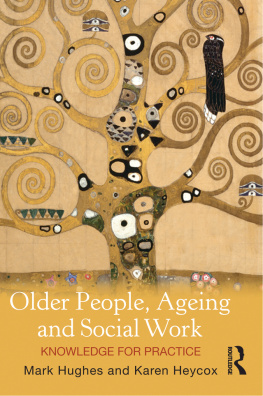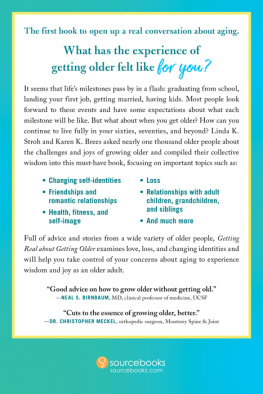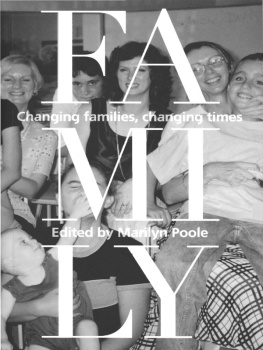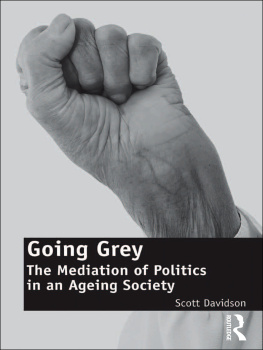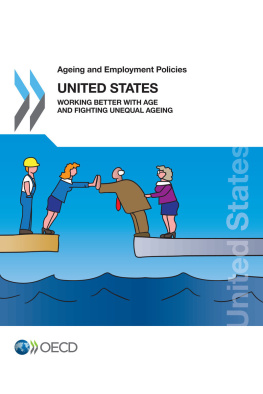INTIMACY AND AGEING
New relationships in later life
Torbjrn Bildtgrd and Peter berg
First published in Great Britain in 2017 by
Policy Press University of Bristol 6th Floor Howard House Queens Avenue Clifton Bristol BS8 1SD UK Tel +44 (0)117 331 5020 Fax +44 (0)117 331 5367 e-mail
North American office: Policy Press c/o The University of Chicago Press 1427 East 60th Street Chicago, IL 60637, USA t: +1 773 702 7700 f: +1 773-702-9756 e:
Policy Press 2017
British Library Cataloguing in Publication Data
A catalogue record for this book is available from the British Library
Library of Congress Cataloging-in-Publication Data
A catalog record for this book has been requested
ISBN 978-1-4473-2649-6 hardcover
ISBN 978-1-4473-2653-3 ePub
ISBN 978-1-4473-2654-0 Mobi
ISBN 978-1-4473-2651-9 ePdf
The right of Torbjrn Bildtgrd and Peter berg to be identified as authors of this work has been asserted by them in accordance with the Copyright, Designs and Patents Act 1988.
All rights reserved: no part of this publication may be reproduced, stored in a retrieval system, or transmitted in any form or by any means, electronic, mechanical, photocopying, recording, or otherwise without the prior permission of Policy Press.
The statements and opinions contained within this publication are solely those of the authors and not of the University of Bristol or Policy Press. The University of Bristol and Policy Press disclaim responsibility for any injury to persons or property resulting from any material published in this publication.
Policy Press works to counter discrimination on grounds of gender, race, disability, age and sexuality.
Cover design by Policy Press
Front cover image: istock
Readers Guide
This book has been optimised for PDA.
Tables may have been presented to accommodate this devices limitations.
Image presentation is limited by this devices limitations.
List of figures and tables
Figures
Tables
Acknowledgements
Writing a book is hard work and demands much time and sacrifice. This book would never have been written without the support of institutions, colleagues and friends.
We would like to thank the research foundations that provided financial support for the two research projects that this book to a large extent is based on, the Swedish Research Council for Health, Working Life and Welfare (Dnr 20090720), and the Swedish Foundation for Humanities and the Social Sciences (P11: 09091). We would also like to thank Harald and Louise Ekmans Research Foundation for providing a one-week scholarship for writing at the Sigtuna Foundations hotel and conference centre, and the Jonsered Foundation for providing a one-month scholarship for writing at Villa Martinson in Partille.
For valuable comments on the book manuscript we would like to thank the anonymous reviewer and the book series editors Chris Phillipson, Toni Calasanti and Tom Scharf. We thank Professor Emeritus Lars Andersson, and the social gerontology group at Uppsala University (Sandra Torres, Gunhild Hammarstrm, Ulla Hellstrm Muhli, Magdalena Kania Lundholm and Marianne Winqvist) for important feedback. We also thank Professor Susan Brown for providing us with statistics from the US.
Last, but not least, we thank our families and wives for invaluable practical and emotional support during the writing process.
We, the authors of this book, have in all parts contributed equally to the drafting of this book, including conception, research design, collection of data, analysis and writing.
Series editors preface
Chris Phillipson (University of Manchester, UK), Toni Calasanti (Virginia Tech, USA) and Thomas Scharf (Newcastle University, UK)
As the global older population continues to expand, new issues and concerns arise for consideration by academics, policy makers and health and social care professionals worldwide. Ageing in a Global Context is a series of books, published by Policy Press in association with the British Society of Gerontology, which aims to influence and transform debates in what has become a fast-moving field in research and policy. The series seeks to achieve this in three main ways. First, the series is publishing books which rethink key questions shaping debates in the study of ageing. This has become especially important given the restructuring of welfare states, alongside the complex nature of population change, both of these elements opening up the need to explore themes which go beyond traditional perspectives in social gerontology. Second, the series represents a response to the impact of globalisation and related processes, these contributing to the erosion of the national boundaries which originally framed the study of ageing. From this has come the emergence of issues explored in various contributions to the series, for example: the impact of transnational migration, cultural diversity, new types of inequality, and contrasting themes relating to ageing in rural and urban areas. Third, a key concern of the series is to explore inter-disciplinary connections in gerontology. Contributions provide a critical assessment of the disciplinary boundaries and territories influencing the study of ageing, creating in the process new perspectives and approaches relevant to the 21st century.
Among the many changes influencing later life, new types of relationships and social ties must rank as one of the most important. In this respect, Torbjrn Biltgrd and Peter bergs contribution to the series is especially welcome, providing a major assessment of changing patterns of intimacy in later life. The authors draw on their own original research in Sweden, together with a large number of international studies, to provide a comprehensive account of intimacy in later life. The book provides an exciting and challenging account, demonstrating the numerous ways in which older people are reshaping social and family life in the 21st century.
ONE
Introduction
This book is about late-life intimate relationships in cross-gender couples. Intimate relationships are among the most important relationships in our lives. They correspond to our longing to feel loved and appreciated, support our sense of self, give us a sense of belonging, and satisfy our physical desires. In other words they correspond to our deepest emotional, psychological and physical needs as human beings. Although these needs are arguably ageless, a widely held idea is that intimacy is associated with the earlier part of the life course, while later life is associated with the loss of intimate relationships and the decline of interest, expectations and physical abilities. This book will challenge this and other normative conceptions and stereotypes of late-life intimacy.
Stereotypes regarding older peoples intimate relationships contribute to maintaining knowledge gaps with regard to late-life intimacy with consequences for ageing policy and practice, but also knowledge gaps in the wider fields of gerontology, family studies and sexology. Using international research, comparative international data and our own Swedish studies, this book will address these knowledge gaps by presenting a comprehensive overview of older peoples attitudes, expectations and experiences of late-life repartnering.
Setting the scene
Consider the following two cohabiting persons who met late in life: Cohabiting Carl is a 70-year-old man with a complex relationship career and several biological and step-children from different marriages. Raised by liberal parents, he had his sexual debut at the age of 15 and had a number of intimate relationships before he met his first wife-tobe at the age of 23. Soon after meeting they moved in together and only after she got pregnant did they marry. The marriage, established in the 1960s (for love and friendship), was not sexually exclusive, and other partners were accepted. After ten years Carl divorced. He then moved to Great Britain where he met his second wife, two years later. He describes the marriage as an emotional roller-coaster that ended in divorce 15 years later. Immediately thereafter he moved to an Asian country, where he met his third wife, whom he again divorced ten years later. After returning to Sweden he actively searched for a new intimate partner in online dating forums and dated a few women.


